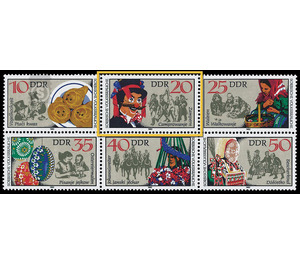Sorbian folk customs - Germany / German Democratic Republic 1982 - 20 Pfennig
Theme: Art & Culture
| Country | Germany / German Democratic Republic |
| Issue Date | 1982 |
| Face Value | 20.00 |
| Color | multi-colored |
| Perforation | K 13:12 1/2 |
| Printing Type | offset |
| Stamp Type | Postage stamp |
| Item Type | Stamp |
| Chronological Issue Number | 2459 |
| Chronological Chapter | GER-DDR |
| SID | 653936 |
| In 14 Wishlists | |
Sorbian folk customs The Ministry of Posts and Telecommunications of the German Democratic Republic publishes six multicolored special postage stamps in sorts of depictions of Sorbian folk customs. No First Day Cover Special cancellation from 6th July to 5th September 1982 Sorbian folk customs in the course of the year Folk customs are certain traditional habits of individual social groups. Based on the socio-economic structure of the Sorbian population in the past, the entire folk culture was characterized village-rural. In accordance with the level of development of the productive forces at that time, superstitious conceptions were often reflected in the customs, since many phenomena in nature and society could not be interpreted and believed in the existence of supernatural powers. If we meet many of the old folk customs today with the Sorbs, then we speak of their form of play, which even today still promotes community. New social groups (e.g., FDJ, Domowina, village club, fire brigade, etc.) act as bearers. In this way, the spiritual-cultural life is enriched especially in the villages, old traditions are preserved, maintained and developed. At the same time, it makes a valuable contribution to the development of a socialist culture and way of life. 20 Pfennig value: Carnival - Zapust In parts of Lusatia is celebrated after winter work, the carnival. We experience the festive carnival parade in many places of Lower Lusatia, where girls or women appear in their pretty folk costumes, as well as zampers. Often disguised figures (the bear, who represents the departing winter, the stork or the white horse rider as messengers of approaching spring and fertility, etc.) often appear.


